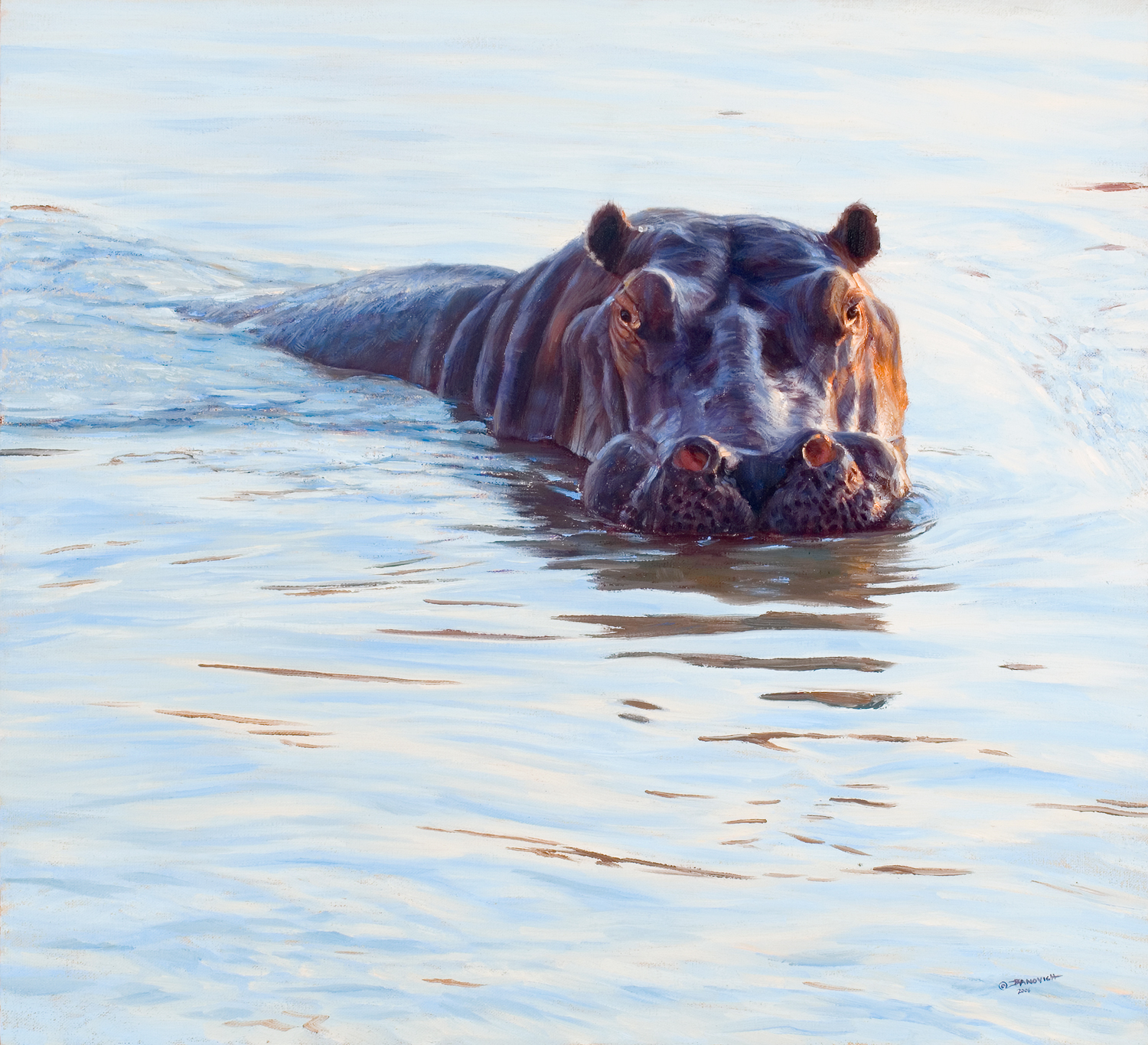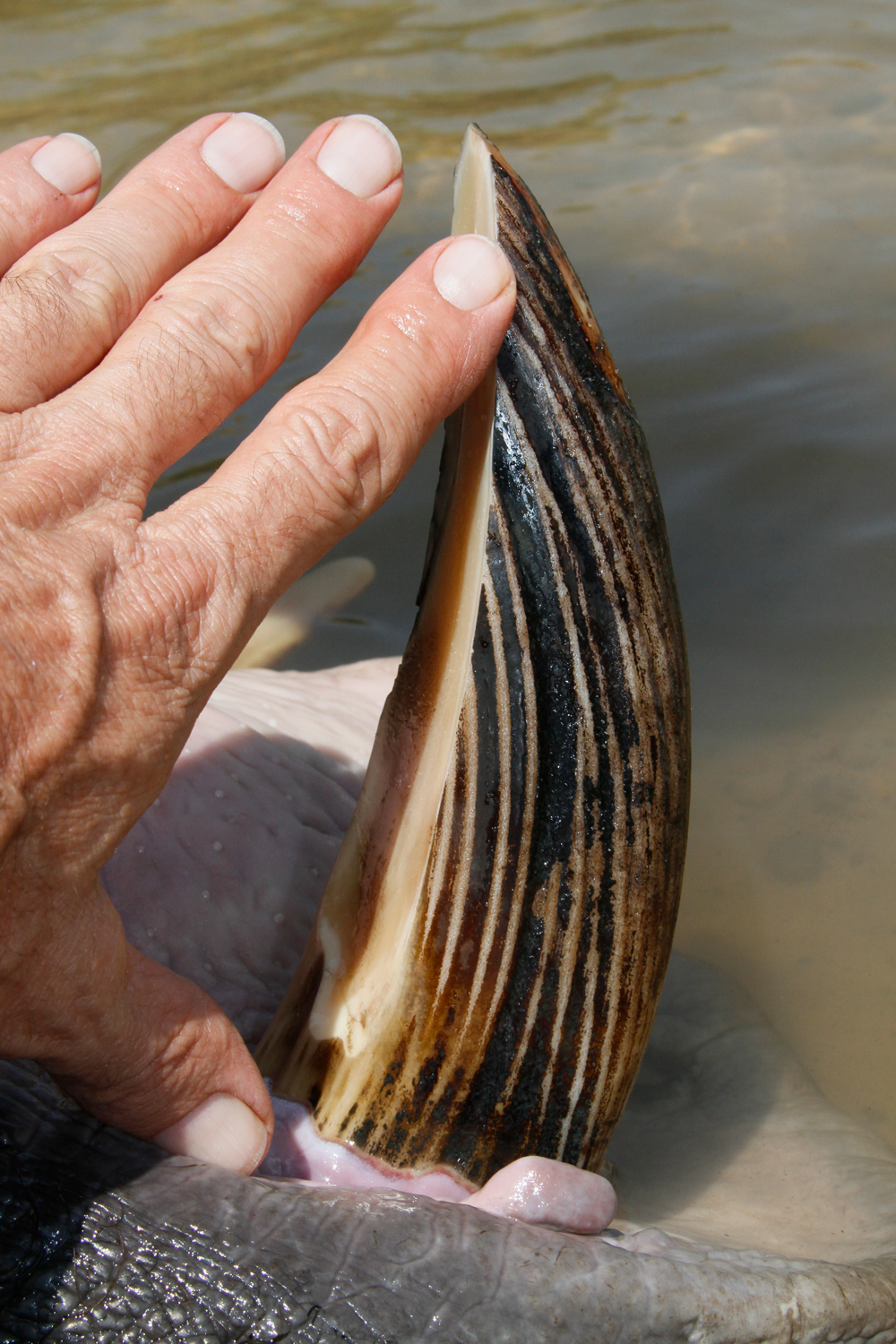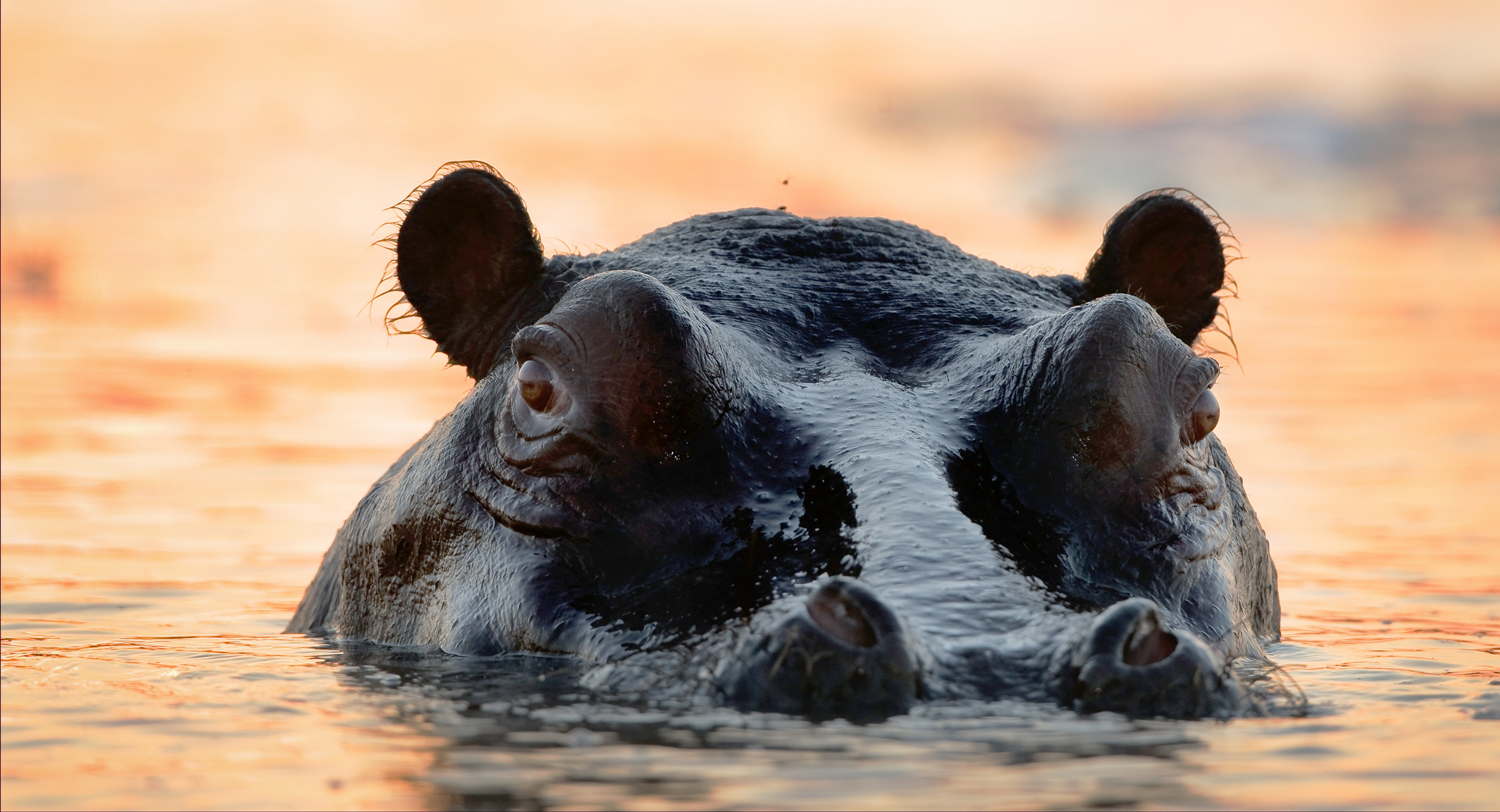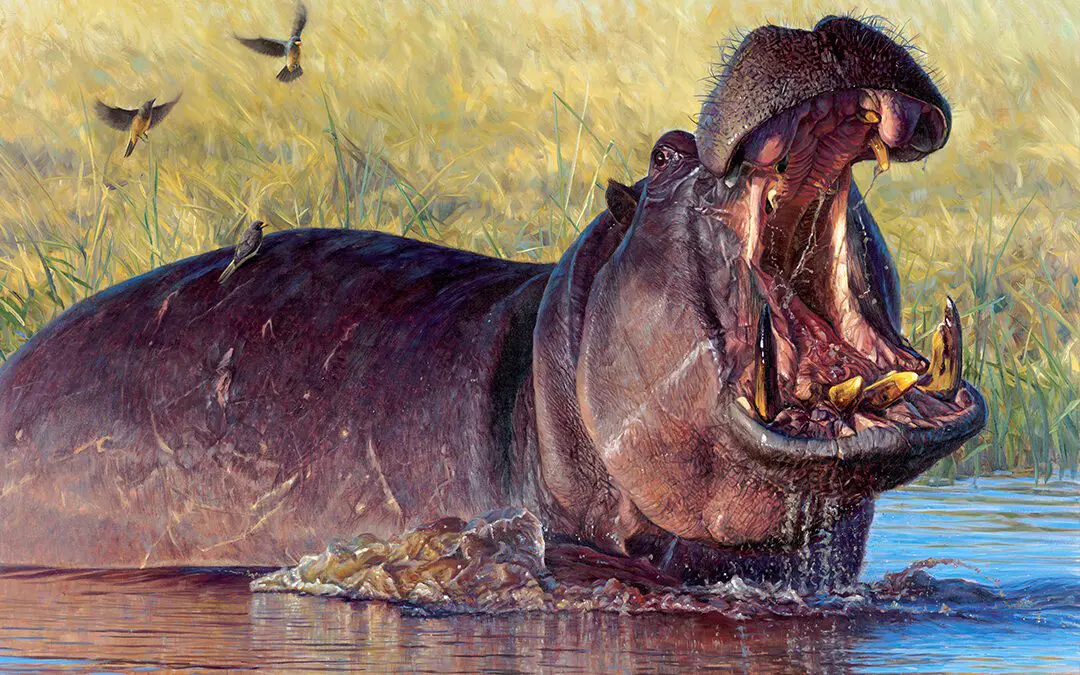Who would have thought that a nice, brisk morning walk could get your torso hung up on a set of giant, prehistoric, enamel meat hooks? But I get ahead of myself. See, there was this dirt road just outside Lew’s safari camp that ran pretty much alongside the Zambezi but at a higher elevation—sort of a really hairy Highway 1 or a lunatic Lake Shore Drive. Early on, I’d taken to doing early morning walks of four or five miles on this road, enjoying the long light, reveling in the sounds of an awakening Africa and absorbing the scents of the place. Initially, I’d asked a couple of the camp staff to come along, but after a few weeks I’d gotten plenty comfortable to go by myself.
One dewy, beautiful morning, I rolled out of the rack, checked my boots for illegal immigrants, chortled at the idea of not touching a razor and stepped out to a waiting breakfast. The camp chef, Adam, was working on a griddle made of a piece of plate steel the size and shape of a sheet of drywall with a campfire underneath. He had eggs and bacon going and a pot of honest to goodness percolating coffee, the kind in the pot with the clear glass knob on the top where you could watch it percolate. All this was imbued with the wonderful, pungent scent of the mopane smoke and the trees and the water.
That handled, I checked to see that my rifle was topped off and had a round chambered, and that I had another 20 rounds in my safari vest pocket. Today, it was a Browning in 300 Winchester Magnum that I took instead of the .375 with the thought that many of the sightlines along the river were long ones, and the flatter trajectory and higher velocity would give me a greater envelope to work with, particularly because I was looking for bush buck. Of course, all of that was predicated on the misconception that I was the one who was going to be doing the hunting.
The human brain is the most complex thing on the planet. Its input and its analysis, its conclusions and its ability to influence its own behavior are fearsome, wonderful and, thus far anyway, largely inexplicable. Mine was busy doing that sequence. First, I was listening to the sound of my boots in the dust and noting how that intersected with the surrounding, whispering cacophony of buzzes, clicks, chitter and hums of all the many things you’d expect to find kiting around in the cradle of life. I was also absorbing the many, varied, shifting scents while watching the way the light played on the foliage, the road and the river below with the sun still low. I was walking east, which of course made it harder to look ahead. Not the absolute best idea I ever had, but it explains how I got as close as I did before I saw it.
There, right smack in the middle of the road, was an itsy-bitsy baby hippopotamus. Even for great strapping fellows like the undersigned whose bloodstream consists of equal parts testosterone, red meat, scotch and malaria cannot help but be overwhelmed with the extraordinary sense that the little creature was unforgivably cute. Indeed, any of us would be less than human if our next reaction was anything other than wanting to scoop her up and pop her under the covers between your stuffed Tigger and your Tickle Me Elmo.
It was the first wild hippo I’d ever seen, and my head was immediately full of 2,000 facts I’d researched on them. Like how they leave the water to forage. That they may go as far as five miles inland for that purpose. That they can eat up to 150 pounds of grass per day. That unlike their communal riverine life, foraging is done solitary unless a mother has a calf with her.
Wait. What was that last part? And with that, I heard momma coming.

River Horse, 2007, by John Banovich, oil on Belgian linen.
It wasn’t the slow crunch of vegetation associated with a leisurely amble back to the road. Nope. It sounded more like a brakeless dump truck downhill from Denver running into a raspberry farm.
My amygdala reached overhead and grabbed both striped handles and pulled, firing my full onboard cortisol load into my bloodstream, a heart-speeding blast of fight-or-flight.
But before we go any further into that adventure, I suppose I ought to give you a little more background about what violent creatures hippos are.
First is the sheer immensity of them. Pictures can’t begin to do them justice. It’s like trying to sense El Capitan peak from a postcard. To paraphrase Douglas Adams, they are so immense that they make infinity itself look mid-sized. The biggest ones go a staggering 9,000 pounds. That’s not just your Chevy Suburban. It’s your Suburban loaded for Memorial Day weekend with 40 cases of Blatz and your full trailer BBQ rig out back.
There is a reason that hippos feel that they can snuffle off to forage all by themselves, and that is that nothing out there can even hope to get them. The last felid with fangs having any prospect whatsoever of getting to a hippo’s vitals got himself stuck in La Brea about 12,000 years ago. Further on size, and to show you that natural selection has a sense of humor, the hippo’s closest living relatives are whales.
Then there is velocity and agility. To look at one of these behemoths while stationary you’d think that it would take three minutes to waddle to the fridge. To the kinetic contrary, they have zero to 20 MPH numbers that would shame a number of cars, and there are some reports of hippos having a top end of 30 MPH. (How, exactly, anybody has been able to determine this is something I’ve wondered. I have to believe that they are radar absorbent). While 20 to 30 miles an hour is not fast by fast-animal standards, I was, at that particular moment, much more interested in how that compared to my own personal best standard.
I was not heartened.
Then, there’s the hippo’s input end. While she would have no interest whatsoever in choking you down her gullet, she would have a furious interest in introducing you to all the precursor events, like shear, sever and stab. And boy, can she. Most people when asked to describe a hippo’s pie cutters will give you a perfect Richard Scarry illustration. The teeth are short and cylindrical like little enamel Pringles cans, suitable more for filling a really big three-ring notebook than, say, shearing you into neat thirds. The surest remedy for that wild misconception—or at least the surest remedy with a correspondingly acceptable survival rate—is to see a hippo’s skull. In a random street survey, 300 people out of 250 will immediately identify the hippo skull not only as a carnivore but a highly murderous and prehistorically extinct one at that. The pointy bits aren’t lined up like Mies Van de Rohe designed them, either. They are angled and canted and protruding in a way that neatly emphasizes function over form—given the rest of the jaw geometry, they are ideal for impaling and shearing things. Better yet, they carry the Pleistocene’s version of maintenance free. When brought together, the upper and lower teeth shear against one another, acting just like a ceramic sharpening stick works on your turkey knife. That brings us to the innate terror induced by their immensity. A big bull will have lower meat hooks as long as a foot and a half. Those teeth are longer than from your elbow to your fingertip.
What, you might ask, is a confirmed herbivore doing waving around a scimitar set like that? The answer, like so much in nature, comes immediately back to the numbers of reproduction. Different species have different reproductive strategies and behaviors. Given the reproductive math involved, in virtually every social arena except Hollywood, males have to compete for females. In some species you can observe the competition while in other species you can’t, but it’s always going on. In the visible ones, there is ground-pawing, snout-snorting, fang-baring, horn-locking along with honest-to-Y-chromosome fights that make really good National Geographic fodder. Under that setup, only the biggest, toughest male gets to push-start the next generation. That’s true of gorillas, lions and hippos. That’s primarily what the scary teeth are for.

When brought together, the upper and lower teeth shear against one another, acting just like a ceramic sharpening stick works on your turkey knife. Photo: Ron Spomer
By way of evolutionary contrast, though, there are other ways of going about the whole competition business. Take, for example, the happy little libidinous creatures that are the bonobo. They behave as though they are all stuck in a hippie commune circa 1969. Everyone does everyone all the time with apparent perfect amiability all around. It wasn’t that natural selection was on a smoke break when the bonobo came through—instead, the competition happens inside the female.
Some primatologist who was either brilliant or a little off or both hit on the idea of measuring and charting the weight of various primate testes as a function of bodyweight. Lo and behold, the mighty, studly 600-pound gorilla is working with equipment that might well induce an inferiority complex. By way of contrast, the happy-go-lucky, diminutive bonobo looks like he’s coming home from the bowling alley. And indeed, the hardware matches the strategies. The 600-pound gorilla isn’t worried about the cable guy or the personal trainer, because he’s already tricep-pressed them into coasters. In contrast, the bonobo simply goes in like a power washer. Anyway, hippos are most emphatically of the “big guy” school of thought, which has profound consequences on their behavior, including a few that were of great interest to me right at that moment.
The big-guy school of thought influences everything from their bridge club to their outhouse manners. Big guys get to be big guys as long as they dominate their group, other males, other species and you. One of the more amusing and less savory ways they do this is that they can operate their tails like an Evinrude outboard, spinning at ridiculous RPM. They do this while emptying every waste product they can manage while directing their derrieres at their social inferiors in the process. The process is unbelievably messy and more or less constant. In this respect, hippos are very much like large law firms.
But most poignantly as I stood on that dirt road, is that big-guy thinking has a major impact on female hippos. That is so because big guy hippos have been known, just as the males of so many other species are known, to kill the prior big guy’s offspring if they can. If Momma is there, she will not stand for it. The underlying math is responsible. Hippos and humans have high investment strategies. A momma sturgeon makes the parenting process look like cluster bombing only briefer. Momma mambas may catch a glimpse as junior writhes off to find his own immediate post-birth breakfast, but that’s it. A momma hog spends time feeding her new arrivals, but she launches litters fit to fill a short school bus. Hippos though, like most humans, have only one at a time and, unlike so many of nature’s quick turnaround artists, gestation is typically one full year. The investment continues well after birth. In contrast to the fire-and-forget species, hippos may let junior live in the basement for several years. All of which means that each and every hippo is a tremendous evolutionary investment and one that’s incredibly difficult to replace.
Momma hippos come wired accordingly.
How accordingly? Well, if you want to take out Junior, you’d better bring everything you have and all your friends, along with one hell of a body bag to put her in because you’re going to need it. There have been photographed events in which a massive and cunning croc thought it was going to have a baby hippo panini, but Momma heard the order go in. What results makes the Battle of Stalingrad look like a game of Angry Birds. Almost always, lizard boy either ends up in segments, or packs it in to go sulk somewhere. Momma absolutely positively will not stop in defense of her young.
It’s even worse than that. So horrifically powerful are the 55-odd million years that have honed her wiring that not only will Momma reduce you to pureed lasagna on behalf of her hippo baby, she will do it on behalf of other species’ babies, too. It’s been observed any number of times, and in 2010 it was filmed. In that instance, as part of the miraculous and incomprehensible event that is the annual wildebeest migration, a passel of them were crossing a river in which there were three things: a bad current, a bunch of crocs and an armored gunboat of a momma hippo.
Things started out alright, with the ungulates splashing into the river. But about the midpoint, in the peak current, one little calf simply didn’t have the strength to fight it and was swept downstream. The mother wildebeest couldn’t help. The best she could do was frantically reach the far bank, then scramble downstream watching the little fellow.
The saurians stirred, opened their slit-pupil eyes and slipped off the bank and into the water.
Lying at mooring with just her great, crested pilothouse out of the water was the H.M.S. Maternity—a monster of a female hippo. As she saw the crocs slide into the water, she fired white signal rockets off the bow and slammed the brass telegraph handle all the way through “Full Ahead” and straight into “Emergency Ramming Speed.”
The muddy water behind her churned up in a froth and she slammed forward pushing a bow wave you could surf. She set a violent collision course with the crocs.

Despite having a brain about the size of a cue ball, crocs routinely show intelligence. Having apparently already had some naval engagements against the H.M.S. Maternity, they decided against any more and backed off. Momma kept course, hooked to the side and hove-to alongside the struggling little wildebeest. Using her massive bow, she proceeded to start to tugboat him to shore.
It was not a done deal yet. The little creature was exhausted, and Momma was being very gentle, as if cognitively aware that she outweighed him by at least 100 to 1. But they made slow progress, and after an agonizing couple of minutes, they made landfall on the far bank. Her tiny consort scrambled up the bank to its mother, to the absolute foot-stomping, rebel-yelling, roaring delight of every mammal present.
The guys I know who went to the University of Chicago like to use words like “heurism.” (They really know that they’ve found the right coffee clatch when somebody else responds with a sentence including the word “normative” or maybe “paradigm.”) Me, I prefer to say “rule of thumb.” Reduced to a rule of thumb, this chapter would read “Keep right the hell away from hippos in general and momma hippos with offspring in particular.”
Which left me with the classic, instant, 500-million-year-old question—fight or flight? Author Malcomb Gladwell has written a book about the subconscious brain’s ability to process information and arrive at conclusions in a big, blazing hurry, long before it actually bothers to tell you. Mine had done just exactly that.
An instant before the runaway dump truck blew through onto the road, I leaped off the far side, onto the steeply descending slope. I hit like a seven-story-stuntman, fell and rolled. From above, the flora had looked like thick but generally benign vegetation. I now had a chance to use all five senses to discern that it was a cross between wrought iron and concertina wire. As I wind milled, tripped and plunged through it, it had mathematically perfect access to seemingly the entire surface area of my body, none of which it wasted. Once back on my feet, I did something that was supposed to be running, if every step in your path had a functioning blender.
A darting glance back and above my left shoulder showed me the black superstructure of momma’s bow and bridge looking off the side of the road on a perfect azimuth at yours truly. To my instant (and not to this day fully dissipated) relief, she remained stationary. Apparently, she was satisfied that my exit stage left was a sincere display of inter-species non-aggression.
At that point, I slowed down, which helped matters enormously. While it took me several minutes to ascend out of the phloem razor ribbon, I managed with relatively few additions to the Jackson Pollock artwork on my calves. I crested the road carefully and was ever-so-happy to find that the hippos had stomped off elsewhere. I turned and went straight back to camp.
Rory started to greet me, paused, then bellowed a general quarters alarm. I stood him down on the to-arms aspect, but enthusiastically endorsed the first-aid component. While I never thought I’d be glad to have a bunch of guys cut my pants off, I desperately wanted to see how bad the damage was and to start cleaning and sterilizing the whole mess.
Many people in Africa have spun up terminally enthusiastic cases of septicemia with a single scratch, and I had perhaps a couple hundred lacerations every one of which would have stalked off in a huff had you called it a mere scratch. Gouges. Tears. Cuts. Punctures. If the camp had had a phone-booth-sized autoclave, I’d have climbed right in, because sitting in a 1,000-degree steam bath would have to hurt less than the antibiotic archeology that was about to start. Lying flat on the table wearing nothing but skivvies, I was about to declare myself petulant. Or maybe even distressed, but then Rory, master of the emergency that he is, showed up with what can only be described as a drum of Vat 69 single malt.
The process was thorough, lengthy and brutal. They carefully probed and swabbed every one of the gashes, seeking any fragments of vegetation. Then they repeated the process with some potent antibiotic I’d brought for more or less this purpose. Well into my de-thorning, and well into the Vat 69, I analyzed my decision to jump. Part of it was, of course, that I would have had only a tiny time period in which to aim and fire. By the time she would have broken through the brush at the side of the road, I might have had one full second to place a perfect shot. A second part of the decision was that I only had the 300 Win. Mag. with me and not the much heavier 375 H&H. In a typical load, a bullet of the latter weighs close to twice the former. That has significant implications for both penetration and energy transfer, which are particularly critical on anything so monstrous as a hippo.
But there was a third reason.
It was the little baby hippo. Now, getting back to you, in your recliner in suburban Arlington. The pool referendum passed. You had too much coffee this morning and are still feeling a bit edgy, so your immediate reaction to my third reason is: “B.S., Miller. You are gratuitously adding the baby hippo so that you will appear noble, charming and irresistible to women.” To be sure, while I have an extended and proven record of not being above such behavior, in this instance preserving the baby actually was one of my reasons. She was tiny and she was cute and something in the core of me really, really wanted her to live.
That was more than 30 years ago. I have never minded the Jackson Pollocks that remain permanently on my calves. To the contrary, they make me think of that little hippo. Had I shot her momma, the little creature’s chances of survival would have dropped enormously. Barring the usual hazards of not having health insurance, hippo live around 60 years, which means that right now she is somewhere in the prime of life.
Definitely the right call.
This was an excerpted from the book Facing the Charge, click here to order your copy today.
In addition to adrenaline-fueled tales of big-game hunting, Facing the Charge details how death is a constant companion on safari in the form of terrorists, quicksand, malaria and witchcraft, among other threats. It also analyzes how ivory traffickers have devastated the elephant population and examines the everyday hardships of life in Africa.

